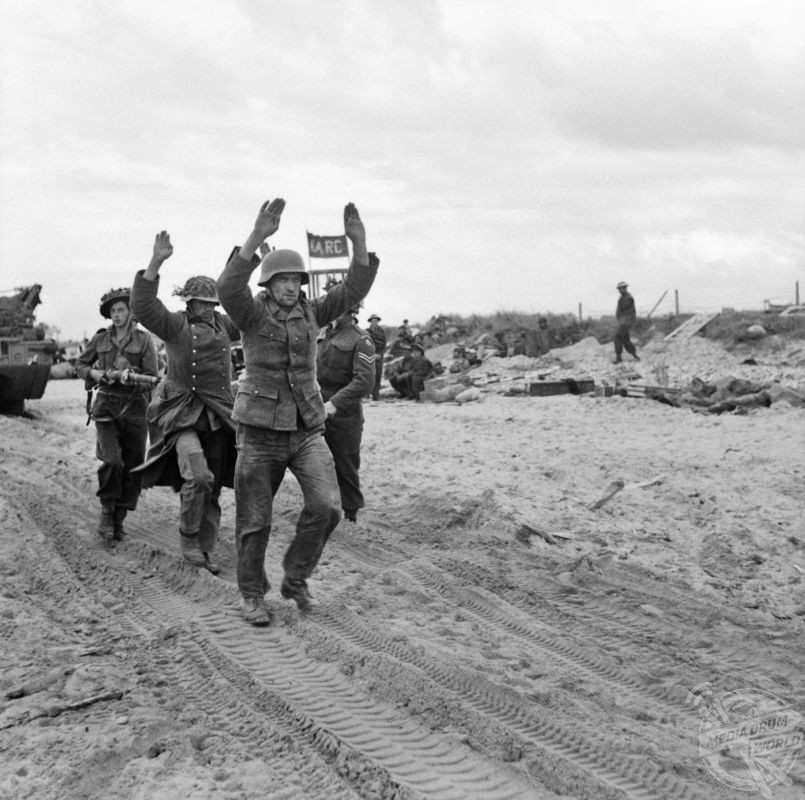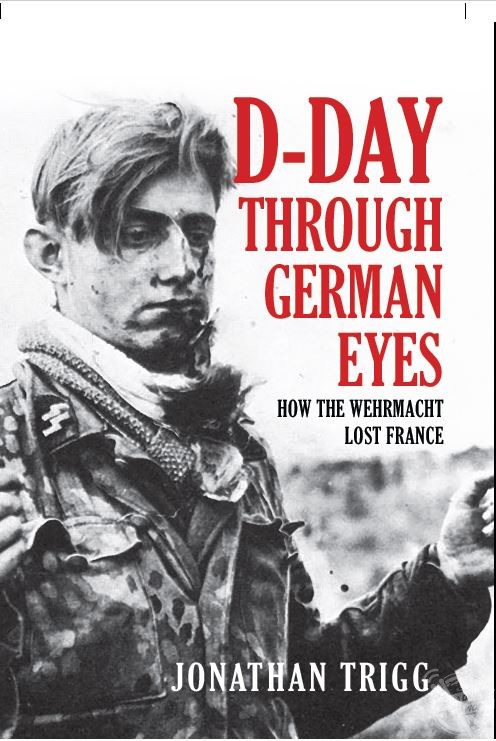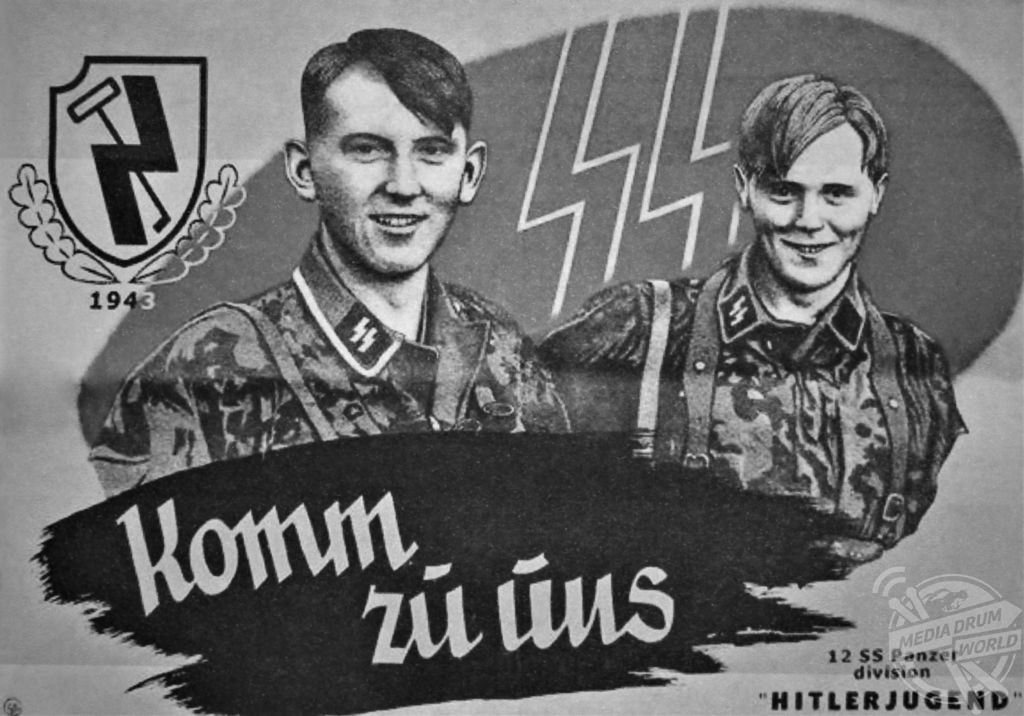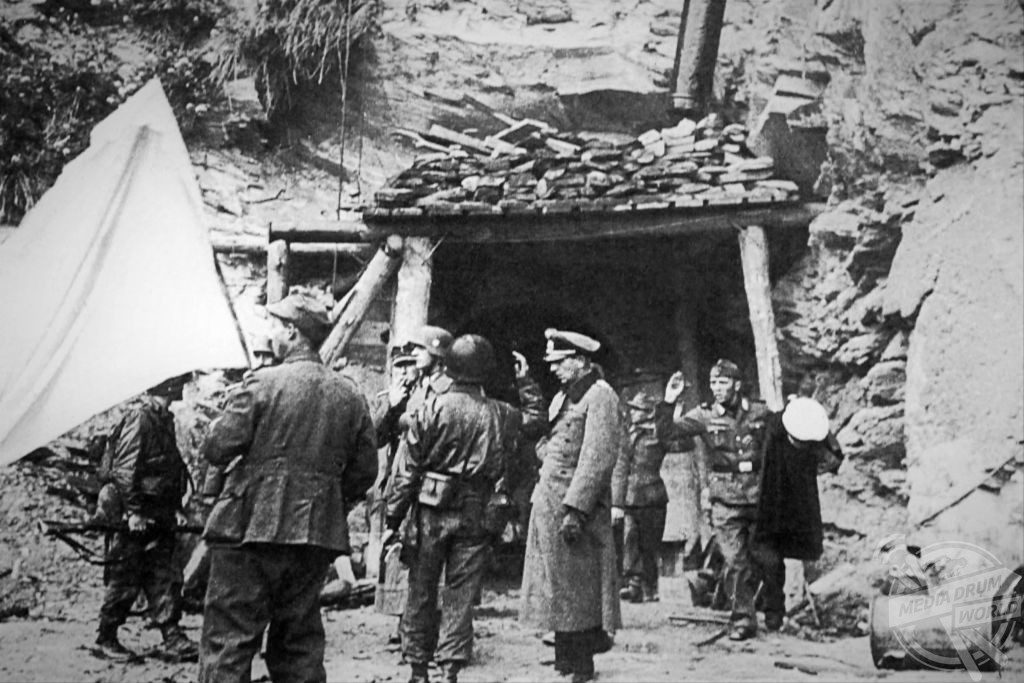
By Alex Jones
FRANCE: A FASCINATING new book explores the horrors of D-Day from the perspective of the losing side, including never before seen photographs and testimonies from one of the most defining conflicts of the Second World War.
The mere mention of the Normandy landings is enough to send a shiver down one’s spine. Anxious, adrenaline-fuelled men crammed into cramped, vomit-strewn boats getting ever closer to the sound of causalities screaming for their mothers, whistling bullets, and chest-achingly loud explosions. Once the ship’s doors dropped, these harrowed soldiers would have to wade out into cold, blood-tinged sea and fight their way up an seemingly endless expanse of sand, over dead colleagues and writhing comrades to face a deeply entrenched enemy armed with machine guns and heavy weaponry trained on you. Worse still, the enemy has been patiently waiting and preparing for your arrival for years. That is the story of the Allied Forces soldiers on June 6, 1944.
But what if you were the swastika-clad soldier manning the machine gun, looking out in horror at the largest amphibious invasion in the history of warfare? Would you still hold faith in Hitler’s Atlantikwall? Would your eyes keep drifting to the skies, desperate to spot some support from the Luftwaffe? Would you surrender?

These are the questions Jonathan Trigg attempts to answer in his new book, D-Day Through German Eyes: How the Wehrmacht Lost France – an account of Operation Overlord from the ‘other side’.
In his fascinating commentary, Trigg includes a collection of unpublished or rarely seen photographs from the D-Day assaults, including a shot of defeated but ultimately relieved German prisoners of war resigned to their fate, an image featuring the absolute destruction of a German Field Army unit, and a smashed tank which has been blown upside down by Allied bombing.
“This book has been published to coincide with the 75th anniversary of the D-Day landings and the subsequent battle for France waged that same summer,” explained the author and ex-soldier.
“It is a truly enormous subject, encompassing the largest amphibious invasion ever undertaken, and an ensuing campaign that involved more than two million men and an unfathomable amount of equipment, supplies and machinery. The challenge I set myself with this book was to boil this enormous clash of arms down to the view from the trenches.
“The amount of paper produced about what became the Normandy campaign could cover all five landing beaches, but very little of that valuable work has been written from the German perspective, and even less from that of the men who did the fighting; not the great names, the Rommels or the von Rundstedts, but the humble German soldier – the landser – and the NCOs and officers who led him and shared his rations, his dangers and his fears.

“This story is of German failure, seen through German eyes, and primarily told by the Germans who were themselves there that fateful summer.”
On paper, Nazi Germany and its allies could be pleased with their defensive position in the summer of 1944. After ousting British and Allied Forces out of France at Dunkirk four years prior, the Nazi war machine had spent the intermittent years developing a strategy to prevent or repel an invasion through north west Europe. Even though they felt it was unlikely that an invasion would take place in northern France, they still keep the coast well stocked with men and machinery.
“The German Wehrmacht had been in France for four long years by the time the ramps of the Allied landing craft came crashing down into the surf on the morning of 6 June 1944, and had somehow – in this the fifth year of the war – managed to find no fewer than fifty-nine divisions to man Hitler’s fabled Festung Europa – ‘Fortress Europe’, while still fighting the Red Army in the depths of the Soviet Union and holding the Anglo-Americans at bay in central Italy,” explained Trigg.
“Four years in which to prepare; to build their defences, plan their response to an attack, practise their counter-moves, observe and understand their enemy and yet that summer, they failed. In less than twenty-four hours after the first Allied boots hit French soil, 24,000 British and American paratroopers were joined ashore by 132,000 of their comrades landed by sea, accompanied by a staggering 20,000 vehicles. The landings were a stunning success. The Wehrmacht suffered anywhere between four to nine thousand casualties on the day itself (the exact figure has never been accurately established), and while the Allies lost more men – about 10,000 in all, with 4,414 confirmed killed – it was still only a fraction of the official pre-assault estimates of 10,000 killed and 30,000 wounded.”
Hitler’s tactic to hold back the Allied Forces failed that June, and failed dramatically. By conceding France and opening up yet another front for Germany’s already over stretched army, the Third Reich set off a chain of events which would only end in their defeat.

“The Nazi’s defence strategy was to build a wall – a wall that would run from the Spanish/French border in the foothills of the Pyrenees in the south, to near enough the Arctic Circle in northern Norway,” added Trigg.
“Along its length there would be 15,000 strongpoints of varying sizes, and it would be completed in five to six months.
“In choosing this approach Hitler and his acquiescent senior officers tried to turn the clock back to a pre-gunpowder age. In that era, the most successful fortifications in history – the walls the Byzantine Emperor Theodosius built in the fifth century to protect Constantinople – stood unbreached for a thousand years, until Ottoman Turkish cannon and tunnelling brought them crashing down. Hitler didn’t even have to look back very far to see the age of the wall in the art of war was over – less than four years earlier his own Wehrmacht had overcome France’s vaunted Maginot Line with ridiculous ease. Regardless, a flawed strategy was then paired with flawed delivery.
“A huge construction programme was initiated, with a workforce comprising fourteen fortress engineer construction battalions, four regular engineer construction battalions, five Rock Drilling Companies and two minelaying companies working in France alone. Hundreds of thousands of workers were involved – many of them forced labour – and only ten per cent of them Germans. At full pitch this host were pouring 769,000 cubic metres of reinforced concrete a month, and in total they laid a staggering 13,134,500 cubic metres, in between being detailed to go and repair damage to the rail network caused by Allied bombing – but it wasn’t enough, it would never be enough.
“As the para Oberstleutnant Fritz Fullriede wrote in his diary afterwards: ‘What a big mouth we had about the Atlantikwall.’”

But an overdependence on the Atlantikwall was not the only issue the Nazis faced in the event of an Allied invasion. Many of the German soldiers manning the wall were either very young, very old, or injured soldiers put back into service too quickly. Hitler’s finest troops were fighting elsewhere, most often on the eastern front, and a lack of experience at ground level would prove telling. Additionally a significant proportion of the defending army was not native Germans – they were Russians, Poles, Georgians, Turkmen, and Czechs – and therefore less motivated to fight and die for Hitler’s oppressive regime.
To add to the German woes, much of the equipment they required was either absent or outdated. Many of the weapons and fortifications on the Atlantikwall were commandeered from defeated opponents and rarely fit for purpose. Hitler’s war machines – which were technically superior to their Allied equivalents but much more laborious to produce – often ended up in St Petersburg or Cassino and were not available to protect Nazi-occupied Normandy. Similarly, the Luftwaffe was struggling to get enough pilots or planes in the air to challenge the Allied Force’s considerable air superiority.
It was undoubtedly a sobering experience to stand on the Atlantikwall as a fresh-faced teenage soldier and face the full force of the Allied Invasion.
Overall, the German forces fought as well as they could that day and proved a staunch adversary for the waves of the Allied invasion that summer. However, Trigg believes that there could be a more telling reason that they lost France.

“The incontrovertible fact of the 1944 French campaign is that the Germans were beaten by an enemy better than them – they lost, and they lost because they did not wage war as well as their opponents,” he stated.
“This should be no surprise. For all its vaunted military expertise and professionalism, the fact remains that Germany has never learnt how to win a war – after all it hasn’t won one since becoming a country.
“The Tommy, the GI, the Canuck arguably may not have been a match for the landser; his machine-gun wasn‘t either, or his tank – but that is only a fragment of the picture.
“The men from Mansfield, Boston and Winnipeg may not have been as good at soldiering as those from Duisburg or Stuttgart, but they kept on going, and the art of war is not about winning the first battle, or the third, or the tenth, it is about winning the last.”
Jonathan Trigg’s book D-Day Through German Eyes: How the Wehrmacht Lost France, published by Amberley, was released last month and is available here.






